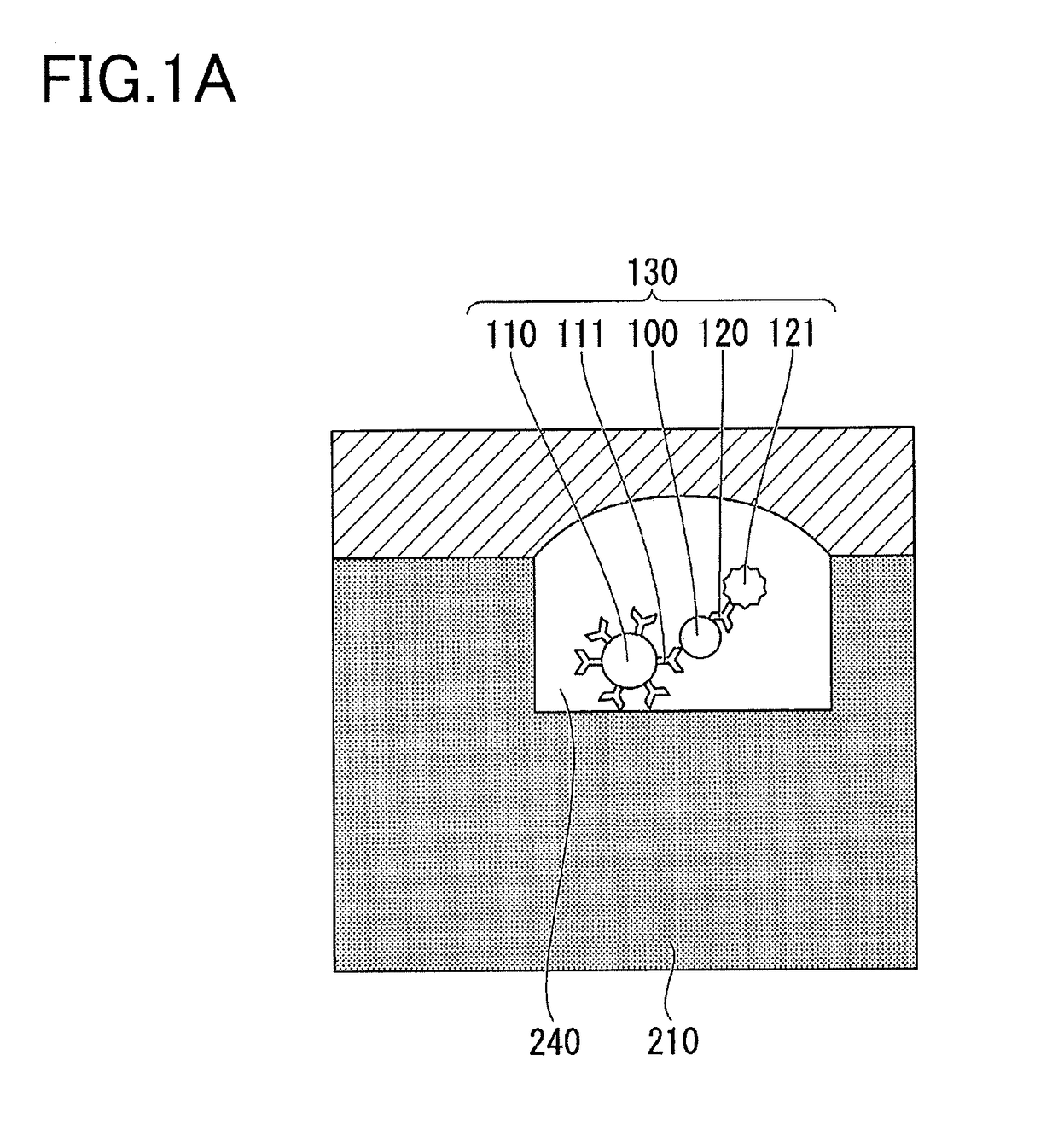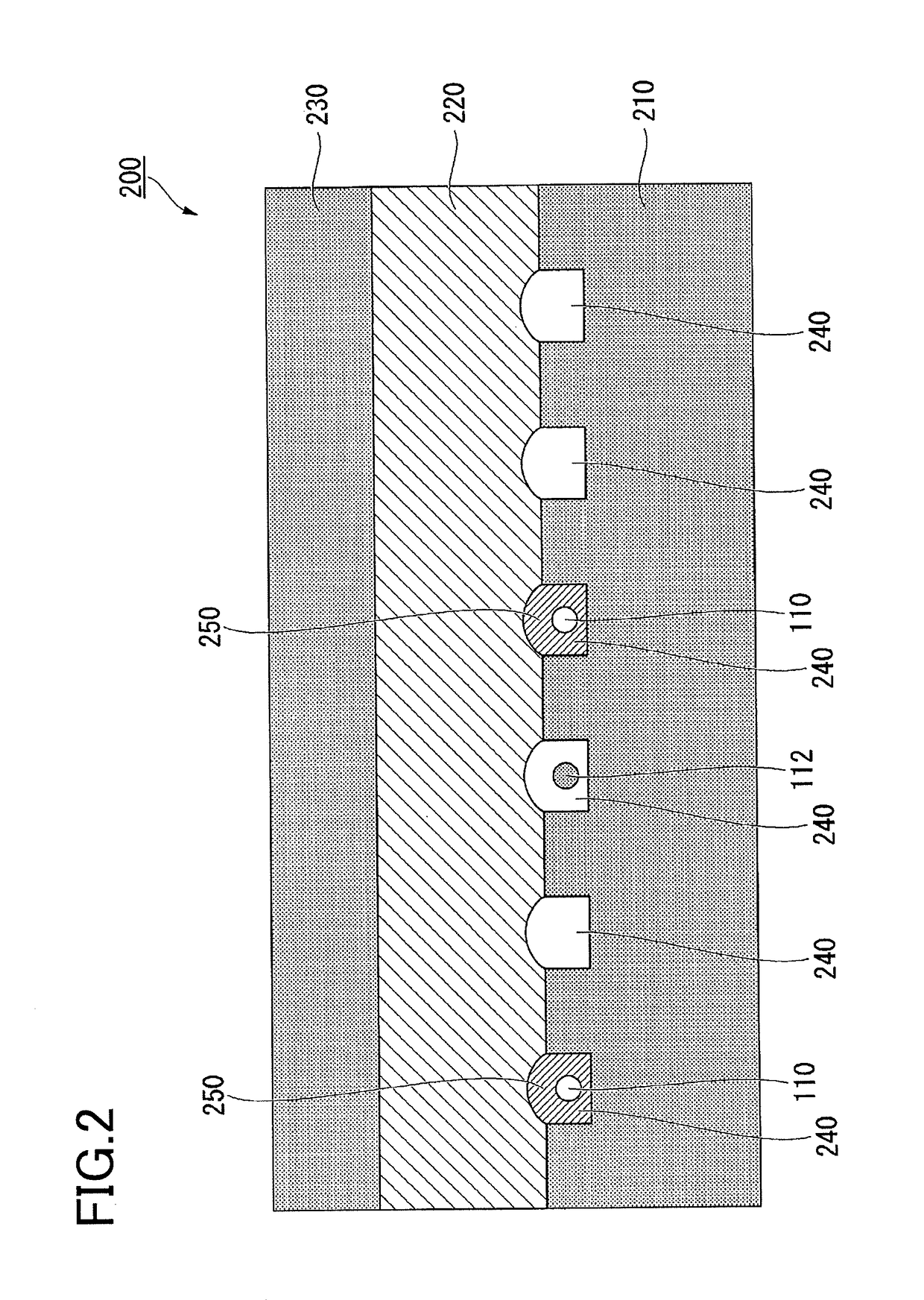Method and kit for target molecule detection
a technology for detecting molecules and kits, applied in the field of methods and kits for detecting molecules, can solve problems such as the decrease in the detection accuracy of substances
- Summary
- Abstract
- Description
- Claims
- Application Information
AI Technical Summary
Benefits of technology
Problems solved by technology
Method used
Image
Examples
first embodiment
[0082]A method for detecting a target molecule according to a first embodiment will be described. FIGS. 3A and 3B are schematic cross-sectional views illustrating a method according to the present embodiment for detecting a target molecule inside a minute compartment. In FIG. 3A, a complex 160 of a target molecule 100, a target molecule capturing particle 110, a specific binding substance 120 for binding to the target molecule 100, and a specific binding substance 122 which recognizes an epitope different from that recognized by the specific binding substance 120, is accommodated in a well 240 formed on the surface of the substrate 210. The specific binding substance 120 has a label 121. The specific binding substance 122 has a label 123. In FIG. 3A, the specific binding substance 111 immobilized on the target molecule capturing particle 110, the specific binding substance 120, and the specific binding substance 122 correctly recognize an epitope of the target molecule 100. The mark...
second embodiment
[0086]A method for detecting a target molecule according to a second embodiment will be described. The detection method according to this embodiment is a method for accurately detecting a plurality of types of target molecules (a plurality of types of first target molecules) at the same time. FIGS. 4A and 4B are schematic cross-sectional views illustrating a method according to this embodiment for detecting a target molecule in a microscopic compartment. In FIG. 4A, a complex 160 of a target molecule 100, a target molecule capturing particle 110, a specific binding substance 120 for binding to the target molecule 100, and a specific binding substance 122 which recognizes an epitope different from that recognized by the specific binding substance 120, is accommodated in a well 240 formed on the surface of the substrate 210. The specific binding substance 120 has a label 121. The specific binding substance 122 has a label 123. In FIG. 4A, the specific binding substance 111 immobilized...
experimental example 1
(Preparation of a Target Molecule Capturing Particle (PSA))
[0121]Target molecule capturing particles were prepared for capturing a prostate-specific antigen (PSA), which is one kind of a prostate cancer marker, as a target molecule.
[0122]First, an anti-PSA monoclonal antibody (type “1H12”, Hytest Ltd.) was biotinylated. For biotinylation, a commercially available kit (trade name “EZ-Link Sulfo-NHS-LC-Biotin”, Thermo Fisher Scientific Inc.) was used. More specifically, Sulfo-NHS-LC-Biotin (500 μL of 0.2 mg / mL) was added to an anti-PSA monoclonal antibody diluted with a phosphate buffer solution (PBS) in a 1.5 mL tube, where a molar amount of Sulfo-NHS-LC-Biotin was 50 times that of the anti-PSA monoclonal antibody. Then, the mixture was allowed to stand on ice for 2 hours, and biotinylation of the antibody was performed.
[0123]Next, in order to remove unreacted Sulfo-NHS-LC-Biotin and reaction by-products from the mixed solution after the reaction, a gel filtration column (type “Zeba ...
PUM
| Property | Measurement | Unit |
|---|---|---|
| depth | aaaaa | aaaaa |
| diameter | aaaaa | aaaaa |
| width | aaaaa | aaaaa |
Abstract
Description
Claims
Application Information
 Login to View More
Login to View More - R&D
- Intellectual Property
- Life Sciences
- Materials
- Tech Scout
- Unparalleled Data Quality
- Higher Quality Content
- 60% Fewer Hallucinations
Browse by: Latest US Patents, China's latest patents, Technical Efficacy Thesaurus, Application Domain, Technology Topic, Popular Technical Reports.
© 2025 PatSnap. All rights reserved.Legal|Privacy policy|Modern Slavery Act Transparency Statement|Sitemap|About US| Contact US: help@patsnap.com



